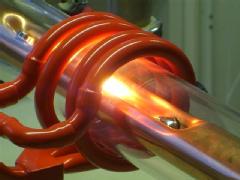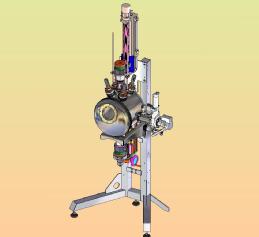Advanced Materials
Science City Advanced Materials programme
During the Science City Research Alliance program (2007 to 2015) researchers at the Universities of Warwick and Birmingham received funding from the regional development agency Advantage West Midlands and the European Research Development Fund (ERDF) to establish the region as an international competitor in advanced materials.
The Science City Advanced Materials programme created a virtual centre to undertake internationally-leading research and development into the creation, development and characterisation of new, advanced materials for applications in a diversity of industries from aerospace engineering to healthcare and information computing technology.
As part of this initiative the Superconductivity and Magnetism Group was given funds in 2007 to upgrade both its single crystal growth and its materials characterisation facilities.
Single Crystal Growth of Metallic and Intermetallic Materials.
|
A radio frequency power generator (Huttinger Trumpf ), capable of delivering 40 kW has been acquired to be used in conjunction with an existing cold boat system. This equipment is used to melt binary and ternary intermetallic compounds in polycrystalline form. Rods of these compounds can also be made using this method in preparation for crystal growth by the floating zone technique. |
 |
| Radio frequency induction heating being used to melt metallic and inter-metallic superconductors and magnetic materials |
 |
A Czochralski tetra arc crystal growth system designed (custom built) and manufactured by Cyberstar(France).
This system can be used in two modes:
This system can be used to produce crystals of intermetallic materials and some oxides can be grown using crucibles made out of precious metals such as platinum and iridium. |
|
Crystal Growth System from Cyberstar (France). The chamber can be used for crystal growth by the Czochralski method, interchangeably with a tetra-arc system or a crucible based growth using induction heating. |
More detailed specifications for this equipment can be found on our Group Research Facilities pages.
Low Temperature and High Magnetic Field - Materials Characterisation
Equipment includes a Quantum Design (QD) Physical Properties Measurements Systems with a 9 T superconducting solenoid. The system can operate at temperatures between 1.8 and 400 K. It has the ac transport (ACT) and thermal transport options which allow us to carry out ac resistivity, 4- and 5- wire Hall, critical current, I-V, thermal conductivity, and thermopower (Seebeck coefficient) measurements. A vertical sample rotator compatible with the ACT option allows transport measurements as a function of the angle between the sample and the applied field, while an easyLab Pcell pressure cell enables resistivity measurements to be performed up to 30 kbar of applied pressure.
A QD dilution refrigerator extends the base temperature of our existing heat capacity measurement capability down to 85 mK.
This initiative also allowed us to obtain a second Quantum Design MPMS SQUID magnetometer and to upgrade our existing MPMS unit. The second system has a 7 T solenoid with both longitudinal and transverse pick up coils and vertical and horizontal sample rotation. Our first MPMS (with a 5 T solenoid) is capable of measuring ac and dc susceptibility and is equipped with an ultra low field option. An easyLab Mcell pressure cell which can be used in both systems allows magnetisation measurements to be carried out at pressures of up to 10 kbar. An i-Quantum He‑3 system extends the base temperature of the magnetometers from 1.8 K down to 480 mK while a QD oven increases the maximum operating temperature from 400 to 800 K.
More detailed specifications for this equipment can be found on our Group Research Facilities pages.







